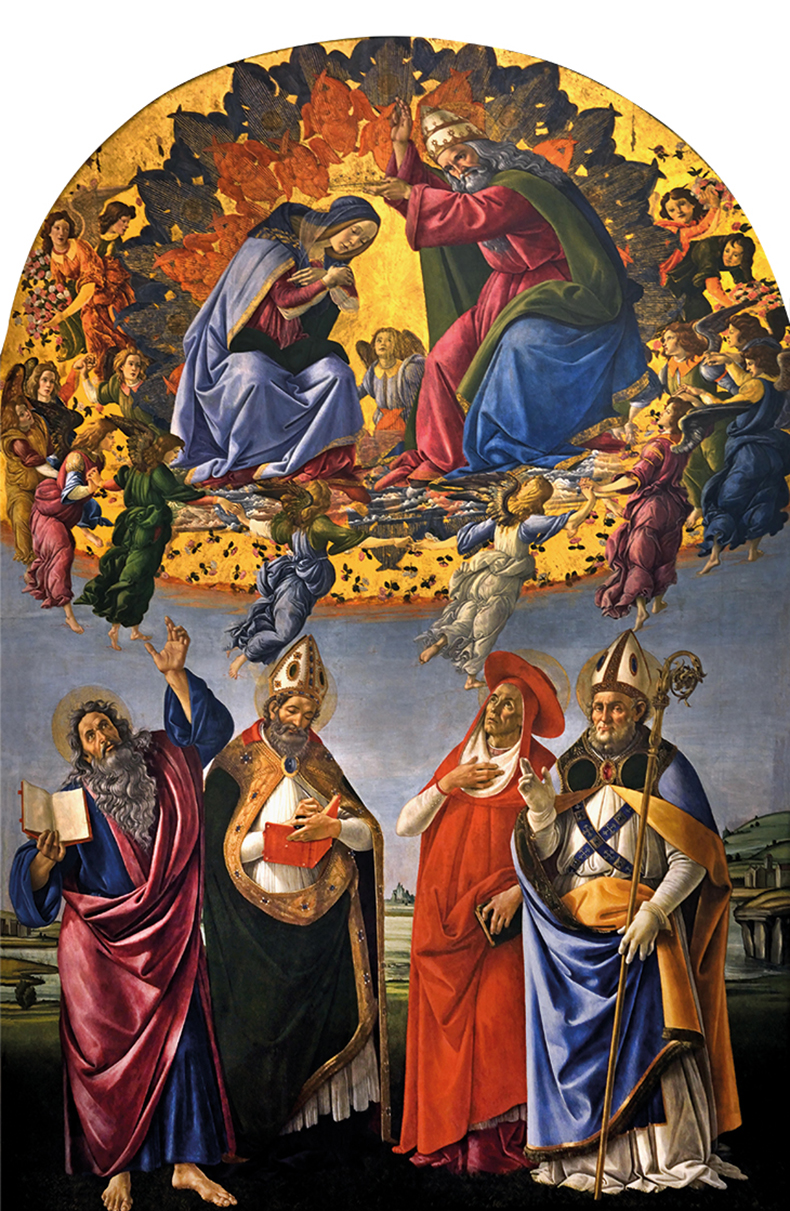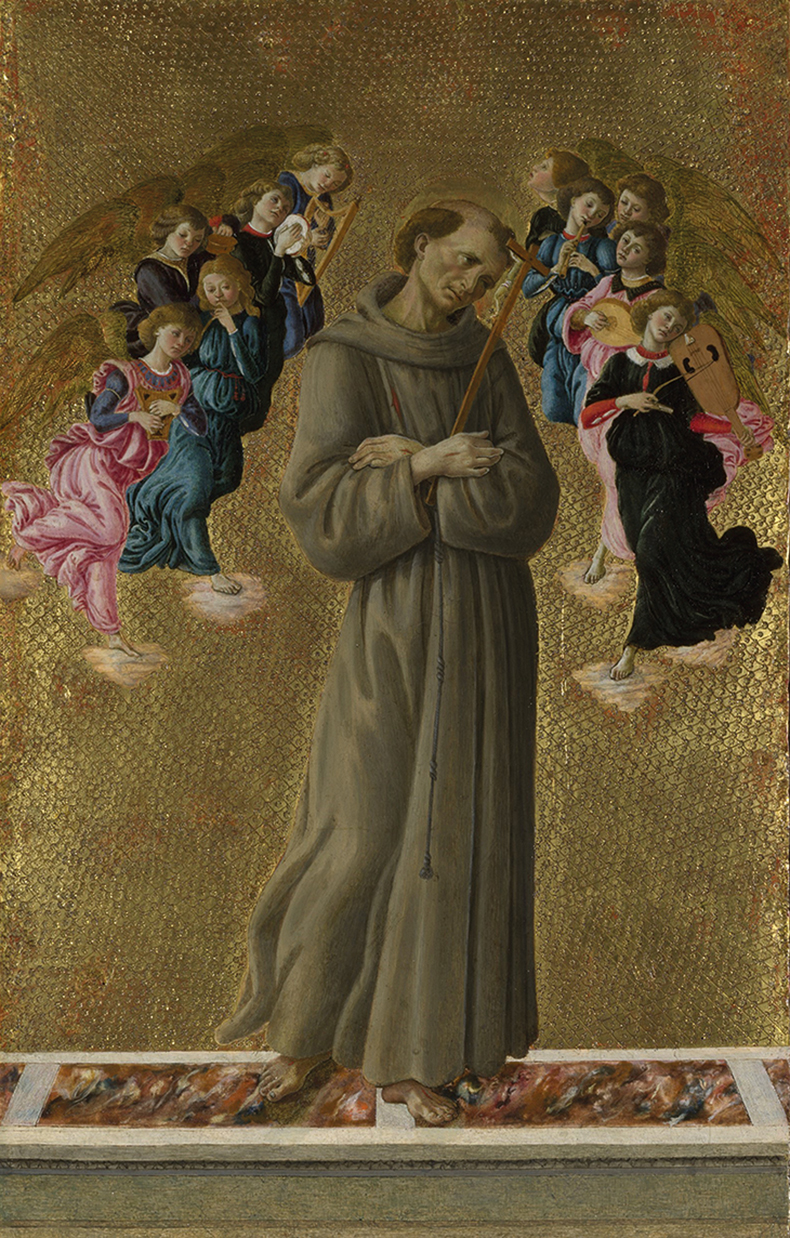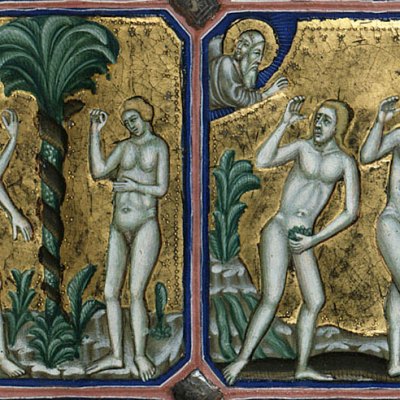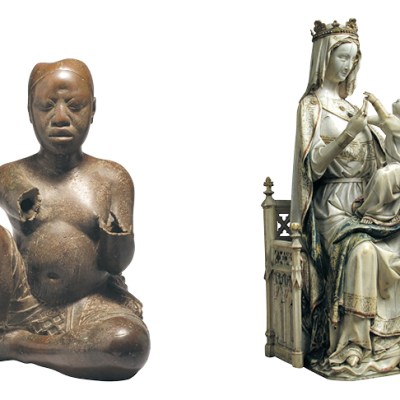From the December 2021 issue of Apollo. Preview and subscribe here.
In January 2021, a portrait of a young man by Sandro Botticelli sold at Sotheby’s New York for $92m, a new record for the artist’s work. The dashing sitter of this painting, which dates to the late 1470s or first half of the 1480s, is an embodiment of clear-eyed, well-dressed youth, cut from the same crushed velvet cloth as that poster boy of Botticelli’s Florence, Giuliano de’ Medici. His golden-brown hair hangs to his shoulders, framed in a window of serene blue sky . So far, so Botticellian. Yet in his hands, this handsome young man presents us with a small roundel, a gilded fragment. His long fingers grasp the panel, steadying its shining circular frame on his fictive ledge that separates his world from ours. This painting within the painting presents another head-and-shoulders portrait of sorts, painted some 140 years earlier by the Sienese artist Bartolomeo Bulgarini (fl. 1337–78). This balding saint, sporting a long, forked greying beard, extracts one hand from his grey-blue robes to give us a two-fingered gesture of silence – the 15th-century equivalent of a finger to the lips.
Portrait of a Young Man Holding a Roundel (late 1470s–mid 1480s), Sandro Botticelli. Private collection Photo: courtesy Sotheby’s

The question of how these two paintings came together is a matter of some debate. Is the roundel original to Botticelli’s conception of this portrait? If so, it may well have held particular significance for the sitter or his family. Botticelli’s portrait of 1474 of a man holding a pastiglia medal of Cosimo de’ Medici is the only other surviving example in the artist’s oeuvre of a show and tell, proclaiming friendship, loyalty or devotion, with the subject holding up an object for our inspection. Any original inscription identifying Bulgarini’s saint has long been lost or removed. However, a fragmentary gabled panel of another balding bearded figure, which was offered and then withdrawn from sale at Sotheby’s in New York in 2014, may provide a clue. This panel, with its figure dressed in similar blue-grey robes and proffering the same two-fingered gesture, contains the cut-off traces of a red-lettered scroll, which would have once identified him as an Old Testament prophet. We might surmise that Bulgarini’s balding saint is the same silent figure.
The panel may have been cut into its roundel – a format associated with ancient coins or portrait medals inspired by antiquity – in preparation for its insertion into Botticelli’s painting. In the 1340s Bulgarini painted a polyptych for the Covoni family in Florence, possibly for the family chapel in Santa Croce. It is possible that the roundel may have belonged to the uppermost section of this work. The saint’s delicately tooled halo is similar to the punchwork decoration on a fragmentary panel of an angel, also thought to come from that polyptych, and his shoulders are framed by two vertical lines of small, circular incisions, suggesting that this roundel was once rectangular, or perhaps gabled in shape.
The technical evidence as to whether Botticelli’s portrait was designed to include this particular object, set in its perfectly sized incision, remains equivocal. The precisely incised lines that encircle the insertion’s painted frame and the lack of damage to the surrounding paintwork indicate that the young man has always held a foreign object. But opinions differ. For some, this painting is an ahistorical amalgamation of alien elements, created to appeal to the modern art market, with the roundel perhaps replacing a damaged pastiglia medal similar to that in Botticelli’s earlier portrait. But for others, including Alexander Nagel and Christopher Wood, this collage is a Botticellian invention that marries the tastes for icons and antiques in later 15th-century Florence. This meeting of gold-ground panel and gilded youth is a juxtaposition that would not have seemed out of place to Botticelli and his contemporaries.
The Coronation of the Virgin (1490–92), Sandro Botticelli. Gallerie degli Uffizi, Florence. Photo: Peter Horree/Alamy Stock Photo

Botticelli is often celebrated as a maker of iconic images, sacred and secular, who ran one of the most successful workshops in Renaissance Florence. The current exhibition at the Musée Jacquemart-André emphasises his career as a celebrated designer and master of line (10 September–24 January 2022). Yet Botticelli – and the young man in his portrait – also lived in a Florence that was full of shimmering gold-ground polyptychs painted by earlier generations of artists, including many of Bulgarini’s Sienese contemporaries. Ugolino di Nerio’s magnificent multi-panelled altarpiece still adorned the high altar in Santa Croce, and Duccio’s Rucellai Madonna still stood in the chapel of the Laudesi confraternity in Santa Maria Novella. These works contained small representations of prophets of a similar scale to Bulgarini’s balding saint. Indeed, the prophets that frame the Rucellai Madonna are even painted within tiny roundels. The multimedia settings of these gilded panels sometimes emphasised their materiality: think of Bernardo Daddi’s miraculous Orsanmichele Virgin and Child (1347–48), housed in Andrea di Cione’s extraordinary marble tabernacle, inlaid with coloured glass, or the Linaioli tabernacle (1432–35), a collaboration between the painter Fra Angelico, woodworker Jacopo di Pietro, sculptors Simone di Nanni and Jacopo di Bartolo da Settignano, and Lorenzo Ghiberti, designer of the marble all’antica frame.
Fragmentary panels like the Bulgarini panel would certainly have been readily available to collectors. In later decades of the 15th century, several altarpieces dating from the previous century were being dismantled, adapted and updated, as churches and chapels were modernised in accordance with new tastes. In the 1480s, Bastiano Mainardi, an associate of Domenico Ghirlandaio, reframed Giotto’s Coronation of the Virgin altarpiece (c. 1334, Baroncelli Chapel, Santa Croce), trimming it down to fit a contemporary all’antica frame. Some pilasters and panels became surplus in this pursuit of modern design, and panels including an image of God the Father (now in the San Diego Museum of Art) that originally sat atop Giotto’s polyptych were separated from their original configurations. The survival of these fragments indicates that they continued to be prized and protected. Indeed, a panel cut from a larger ensemble shares many qualities with smaller works painted to be used by individuals in their private devotions – including some of the smaller paintings produced by Botticelli and his workshop.
Mystic Nativity (1500), Sandro Botticelli. National Gallery, London. Photo: © The National Gallery, London

Later in his career, Botticelli employed the otherworldly effects of beaten gold grounds to create one of his most extraordinary examples of these smaller paintings intended for domestic use. The Mystic Nativity (1501), his only signed and dated work, includes a circular skylight to the golden dome of heaven above. Discovered by the antiquarian William Young Ottley at the Villa Aldobrandini in the late 18th century, it may have been painted for a member of the powerful Aldobrandini family, devotees of radical preacher Girolamo Savonarola, who had been burned at the stake in 1498. Twelve angels carrying olive branches encircle this heavenly opening, their divine bodies poised on this threshold between gilded heaven and painted earth. The painting is often said to mark Botticelli’s later turn towards a medievalising archaism, with its dream-like colours and figures sized according to their significance. The gold ground of the heavenly dome above contributes to that disquieting sense, with its flat suggestion of the infinite.
However, the Mystic Nativity by no means marks a significant change in the artist’s appreciation for working with gold. He had used that heavenly device – the opening window into a gilded heaven, encircled by liminal angels, – nearly a decade earlier in his San Marco altarpiece, the Coronation of the Virgin (1490–92). Commissioned by the guild of goldsmiths, this panel uses an unusual amount of gold in its preparation, not all of which is visible to the naked eye. Cherubim and seraphim were painted over the gold-leaf ground before careful radiating incisions were scored through, to create divine rays emanating from the centre of the heavenly dome.
It is no surprise that this most prestigious commission for the guild of goldsmiths made ample use of gold leaf applied to panel. In the 14th century the goldsmiths’ guild decreed that their members could make artworks using only gold derived from Florentine coinage, a reliable source of the highest-quality gold available. The leaf used in painting – and that used to create gold thread for textile production – was hammered directly from gold currency by gold beaters, subject to strict regulations.
Painters before Botticelli had developed their techniques of working gold in response to innovations in gold coinage. In 1252, the minting of the florin had transformed artistic practice in Florence. From the eighth to the 13th centuries there was far less gold in the West than there had been in antiquity. The return to the gold standard was made possible thanks to trans-Saharan trade with the goldfields of West Africa, which brought dust, nuggets and bullion to Italy. In the 14th century, the famous pilgrimage to Mecca by the emperor of Mali, Kankan Mansa Musa, drew further attention to the golden riches of West Africa and trade routes and sites of exchange proliferated. Artists of the 14th and earlier 15th centuries had also been interested in the malleability of gold, which they worked to imitate metalwork and textiles.
Saint Francis of Assisi with Angels (c. 1475–80), Sandro Botticelli. National Gallery, London. Photo: © The National Gallery, London

Botticelli seems to have shared these interests – and one of his earliest surviving paintings, discussed by Sally Korman in Apollo in July 2003, sheds further light on the taste for gold-ground paintings in this period, which extended far beyond the Midan circles of the goldsmith’s guild and supporters of Savonarola. Acquired by the National Gallery as a work by Filippino Lippi in 1858, the small panel of Saint Francis was probably painted for a lay patron in the late 1470s, making it roughly contemporary with Botticelli’s Portrait of a Young Man Holding a Roundel. The first owner of the painting may have had particular devotion to Francis’s wounds, and to the saint as another Christ (alter Christus). The painting used to bear a later inscription, a fragment of a hymn celebrating the Feast of the Stigmata, which was removed during restoration work in the 1940s; it may nonetheless have replaced an older inscription of the same text. The painting was first published in the early 19th century with an attribution to Botticelli’s Sienese contemporary Matteo di Giovanni (1436–1501), a producer of dazzling golden works for the gilded clientele of Siena.
As a painting of a single saint that was almost certainly intended as such, the Saint Francis panel is unique among Botticelli’s surviving works; other images of single saints in the painter’s oeuvre were once fragments of larger paintings. Its gold ground is also highly unusual. The background is incised with diagonal lines to form a diaper pattern, and tooled with two different punches of five and six petalled stars. The effect is more random than precise, however, and it is deliberately decorative. This tooling was added after the panel had been painted and the incisions sometimes cut into the painted layer. This runs contrary to the usual practice of preparation of panels like this, which were usually gilded and punched prior to the addition of paint layers. Though rather an afterthought – and possibly a later addition – the texture added to the panel’s gold would have caused it to shimmer in candlelight, drawing attention to its reflective properties as well as offering a symbol of a divine dimension. Whoever commissioned this work, it is clear that these gilded, shimmering effects were a particular request – and substantial expenditure.
The Saint Francis might be a rare example of its kind, but its appearance nudges at a contemporary craze for collecting Byzantine icons, both painted panels and micromosaics. After the Ferrara-Florence Council of 1438–39, which heralded the arrival of visitors from the eastern church, and the Fall of Constantinople in 1453, icons were imported into Italy in increasing numbers. Micromosaics were particularly prized. Lorenzo de’ Medici had 11 mosaic icons in his personal art collection. The portable icon of the Virgin of Compassion of the early 1300s (today in the Metropolitan Museum of Art) has an inscription on its reverse written in the hand of a 15th-century humanist, who believed this work was the very same image that had converted Saint Catherine of Alexandria to Christianity: an icon and contact relic in one. Unlike the paintings produced by Botticelli and his contemporaries, these artworks seemed authorless. This lack of authorship, together with their eastern origin and perceived antiquity, contributed to their authority as images of holy figures.
Portable icon with the Virgin Eleousa (early 1300s), anonymous artist. Metropolitan Museum of Art, New York

Icon collecting was not just confined to objects from Byzantium. Piero de’ Medici, Lorenzo’s son, deliberately sought out a double-sided panel that he believed to be by Cimabue, who worked a generation before Giotto, and whose name is also found in the inventories of contemporary collectors. As the trade in icons flourished, panels like the Bulgarini roundel also circulated among collectors and artists. What exactly these collectors thought of their fragmentary antiques and icons is a matter of speculation. Did Piero de’ Medici seek out a panel by Cimabue for its properties as an icon, or as a work of art? By this date, images did not need to claim origins in Byzantium to be treated as ancient relics or miraculous images. Yet works such as Botticelli’s Saint Francis suggest that there was also a market for contemporary art that engaged with the properties of the iconic: heavenly light, manifested in material splendour.
What would Botticelli have thought of these countless little fragments of gilt panel that were circulating among the antiquarians of his day? What would he have made of Bulgarini’s ageing prophet? The jury may still be out on the date that the roundel was inserted into his portrait, but just as the young man holding his roundel invites us to inspect this work, the individual who united these two paintings invites us to imagine a relationship between them. Whoever made this introduction, their actions have preserved Bulgarini’s painting to receive the best kind of care (and a value that surely forms a share of that sale price of $92m). Whatever the date of its insertion, the roundel reminds us that Botticelli was an artist who worked with gold throughout his career – and was also, perhaps, an artist who looked to the intricately tooled, glittering panels of his Sienese predecessors, which still adorned the churches of his city. The painting within a painting is a window into Botticelli’s world, which was more archaic, gilded and materially splendid than his most famous works would suggest.
‘Botticelli: Artist and Designer’ was at the Musée Jacquemart-André, Paris, from 10 September 2021–24 January.
From the December 2021 issue of Apollo. Preview and subscribe here.


